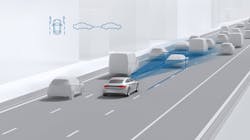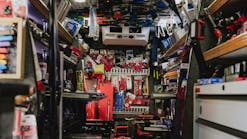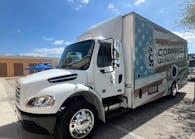Understanding how to upsell ADAS capabilities as a tool distributor
ADAS here, ADAS there, ADAS everywhere. But what is it, and does it have a place on the tool truck? Let’s explore.
First of all, what is it?
Advanced driver assistance systems (ADAS) are systems in a vehicle designed to help a driver. These features have become relatively mainstream in newer vehicle models, and include: lane departure warning, collision warning, adaptive cruise control, adaptive light control, automatic braking, automatic parking, blind spot detection and more.
ADAS requires more sensors and cameras on a vehicle than ever before. With more ADAS-equipped vehicles on the road, shop owners and technicians are now facing a new repair challenge: recalibration.
“To be honest, I’m not sure how a shop will be able to operate without some level of support for ADAS going forward,” explains Ben Johnson, Mitchell 1’s director of product management. “There are simply so many cameras, sensors, LiDAR and radar systems positioned strategically around the vehicle to support these systems. It’s going to be difficult to perform many common services without having to remove an ADAS component to get at the component you’re trying to replace or service. Just removing and reinstalling that component can affect its placement on the vehicle, and for many of these components that requires recalibration to ensure the safety features operate as intended.”
Some vehicles even require calibrations after a simple four-wheel alignment, Johnson says.
Because the chance of unintentionally throwing an ADAS sensor out of calibration during even standard repairs is so high, which could lead to unintentional vehicle behavior or an accident, many shops see value in education and preparation to avoid liability.
If it’s important for repair shops, it’s important for distributors, too.
“Many new car dealers are not yet equipped for [servicing ADAS] so the opportunity for general repair shops are huge,” says Mike Flink, Autel’s national training and sales manager. “This also makes some dealerships potential customers. Body shops, insurers and car owners are searching for facilities in an area who can perform these calibrations and services.”
So what do shops need to perform an ADAS calibration, and what can tool distributors offer their customers as they prepare for the next “big thing” in vehicle repair? The answer can be broken down into three parts: a scan tool, calibration targets and repair information.
Scan tool
Offering and stocking scan tools with ADAS capabilities is the most efficient and affordable way for a distributor to serve shops with ADAS repair needs.
Some sensors and cameras require only dynamic calibration, which requires a technician to utilize a scan tool with ADAS capabilities. Often required by ADAS systems in domestic vehicles, cameras and sensors can calibrate themselves using roadside markers while technicians physically drive a vehicle, following instructions on a scan tool.
Distributors can use these related features as a selling point when comparing different scan tools in order to guide technicians to larger investments.
Consider the following questions to gauge customer interest and need for ADAS capabilities in their scan tools:
- Do you work on domestic vehicles?
- How often do you need to perform dynamic calibration?
- Does your shop perform wheel alignments?
- Does your shop do sublet work for body shops?
- How many customers does your shop have with cars four years old or newer?
- What impact does ADAS have on repair times and turnaround?
For those unsure of how often they run into ADAS, Autel’s Fink advises distributors to give shop owners a homework assignment: have technicians take note of what controls on the dash or steering wheel they are seeing on the cars they are working on. Are there controls for lane departure systems or adaptive cruise control? What are they doing now when a repair to these systems are needed?
Autel offers ADAS information on all larger, up-to-date Maxisys scanners, which includes video explainers. Fink advises distributors use this as a supplemental material for selling.
Calibration targets
The next puzzle piece needed for some ADAS calibrations are calibration targets.
The optical targets sets mentioned here are used when the cameras or sensors within a vehicle's ADAS require static calibration, rather than dynamic.
Static calibration requires shop owners to set up large targets, different for every make, model and type of sensor, at the appropriate height and distance. Asian and European vehicles often require static calibration of their ADAS.
These are large, heavy and expensive (you could easily spend $20,000 on factory targets) to stock.
Because of these factors, John Jenkins, president of CAS New England, advises mobile distributors against stocking them, saying it’s not feasible for a mobile distributor to buy and resell targets on a truck. Even with that aside, it’s not always an easy sell to shop owners because of the space it requires in the bay.
“To perform ADAS calibrations on many vehicles requires specialized targets, equipment, fixtures and space,” Mitchell 1’s Johnson says. “Of these, space might be the biggest challenge for shops.”
Many common vehicles need an unobstructed area of around 32’ long and around 45’ wide, according to Johnson, adding that calibrations generally must be done inside as sunlight can affect the calibration.
“Not every shop is going to be able to perform [ADAS calibration], even if they invest in the equipment to do it,” Johnson explains.
Repair information
The third and perhaps most important piece to performing ADAS calibration is repair information. Even if a shop has the scan tools and the calibration targets, it’s essentially useless without direction.
While mobile distributors don't often provide repair information, it’s beneficial to know its place in ADAS repair.
Consider all the questions buzzing in a technician's brain: Which type of calibration should I perform: static or dynamic? How high is the target supposed to be in relation to the vehicle? At what distance? At which part of the vehicle is this distance from the target being measured? How fast do I drive the car?
“Quite often the scan tools will tell you how to drive the car [for dynamic calibrations], but it’s the targeting – when you’re doing a static calibration – that the techs will have some issue [with],” CAS’s Jenkins says.
In general, repair information for ADAS calibrations can be found in three ways:
- Through an aftermarket service information provider. Some examples are Mitchell 1, ALLDATA and Identifix.
- Purchased through the original equipment manufacturers website. If a shop has a subscription, the information may already be available.
- Integrated information in an aftermarket factory scan tool.
“The first thing a shop and its technicians need is the information to identify what systems a vehicle in their shop might have, and when those systems require calibration,” Mitchell 1’s Johnson says. “Shops can refer to their repair information resource to find this information. For instance, the ProDemand software from Mitchell 1 includes an ADAS quick-reference button to do just that. In one click, a technician or shop owner can determine if the vehicle in their bay has ADAS components, if and when those components require calibration and if there are special tools required to perform those calibrations. Quick reference tools like this are going to be essential to understanding the needs of the vehicles, and to ensure the safety of the drivers and passengers.”
Conclusion
There’s no doubt that ADAS is coming, and is already here. As a mobile tool distributor, consider the most effective ways your business and customers can benefit from selling into this repair category.
Maybe a distributor can’t stock every calibration target on the market, but they can choose to stock ADAS-capable scan tools and the knowledge to back up their selling points.



